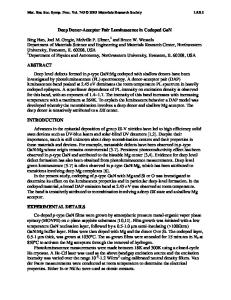Experimental Evidence for Nitrogen as a Deep Acceptor in ZnO
- PDF / 499,865 Bytes
- 6 Pages / 612 x 792 pts (letter) Page_size
- 67 Downloads / 363 Views
Experimental Evidence for Nitrogen as a Deep Acceptor in ZnO M.C. Tarun,1 M. Zafar Iqbal,2 M.D. McCluskey,1 J. Huso,3 and L. Bergman3 1 Department of Physics and Materials Science Program, Washington State University Pullman, WA 99164-2814, U.S.A. 2 Department of Physics, COMSATS Institute of Information Technology Islamabad 44000, Pakistan 3 Department of Physics, University of Idaho Moscow, ID 83844, U.S.A. ABSTRACT While zinc oxide is a promising material for blue and UV solid-state lighting devices, the lack of p-type doping has prevented ZnO from becoming a dominant material for optoelectronic applications. Over the past decade, numerous reports have claimed that nitrogen is a viable ptype dopant in ZnO. However, recent calculations by Lyons, Janotti, and Van de Walle [Appl. Phys. Lett. 95, 252105 (2009)] suggest that nitrogen is a deep acceptor. In our work, we performed photoluminescence (PL) measurements on bulk, single crystal ZnO grown by chemical vapor transport. Nitrogen doping was achieved by growing in ammonia. In prior work at room temperature, we observed a broad PL band at ~1.7 eV, with an excitation threshold of ~2.2 eV, consistent with the calculated configuration-coordinate diagram. In the present work, at liquid-helium temperatures, the PL emission increases in intensity and red-shifts by ~0.2 eV. A peak is observed at 3.267 eV, which we tentatively attribute to an exciton bound to a nitrogen acceptor. Our experimental results indicate that nitrogen is indeed a deep acceptor and cannot be used to produce p-type ZnO. INTRODUCTION Zinc oxide (ZnO) is a direct-gap semiconductor with a wide band gap (~3.4 eV at 300 K) and efficient excitonic emission at room temperature [1]. It is a promising material for various electronic and optical applications, including blue/UV light-emitting diodes and lasers. A reliable p-type dopant is, however, an outstanding problem that must be overcome for practical device applications [2]. Nitrogen substituting on a host oxygen site, NO, has been discussed as a possible acceptor dopant (Table I). Many experimental [3,4,5] investigations suggested that NO has a shallow acceptor level in ZnO, with an acceptor binding energy of ~200 meV. Theoretical studies suggested a somewhat deeper level, roughly 0.3 to 0.5 eV above the valence-band maximum [6,7]. As reviewed in Ref. 2, reports of p-type ZnO are controversial. Like sightings of UFOs or Elvis, reports appear on a weekly or monthly basis. Table I lists several highly cited experimental papers that have reported p-type ZnO via doping with group-V elements. While these results initially seemed promising, repeatability has been a problem. It has been pointed out that the Hall effect, for example, can give the “wrong” carrier type if a sample is inhomogeneous [8]. To address these issues, Lyons, Janotti, and Van de Walle [9] calculated the properties of nitrogen in ZnO using density functional theory (DFT) with hybrid functionals. Their
calculations show that NO is a deep acceptor, with the (0/-) acceptor level 1.3 eV abov
Data Loading...











